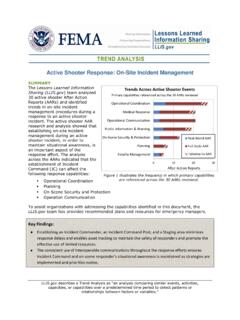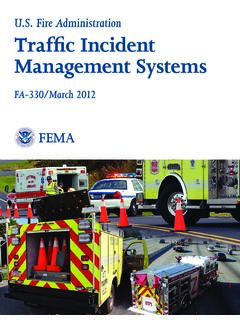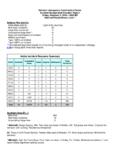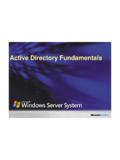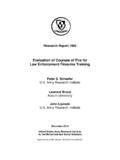Transcription of BY ORDER OF THE SECRETARY AIR FORCE MANUAL …
1 BY ORDER OF THE SECRETARY OF THE AIR FORCE AIR FORCE MANUAL 10-2504 13 MARCH 2013 Operations AIR FORCE incident MANAGEMENT GUIDANCE FOR MAJOR ACCIDENTS AND NATURAL DISASTERS COMPLIANCE WITH THIS PUBLICATION IS MANDATORY ACCESSIBILITY: Publications and forms are available for downloading or ordering on the e-Publishing website at RELEASABILITY: There are no releasability restrictions on this publication OPR: AFCEC/CXR Certified by: AF/A7CX (Col Darren P. Gibbs) Pages: 60 This MANUAL implements Air FORCE Instruction (AFI) 10-2501, Air FORCE Emergency Management Program Planning and Operations. It also aligns the Air FORCE Emergency Management Program with Presidential Policy Directive (PPD)-8, National Preparedness, Homeland Security Presidential Directive 5 (HSPD-5), the National incident Management System (NIMS) and the National Response Framework (NRF).
2 This MANUAL integrates major accident and natural disaster procedures, and standards for planning, logistical requirements, emergency response actions, emergency response organizational guidelines, exercises and evaluations, personnel training, detection, identification, warning and notification actions. It establishes responsibilities, procedures and standards for prevention, preparedness, response, recovery, and mitigation resulting from major accidents or natural disasters within the continental United States (CONUS) and Outside the Continental United States (OCONUS). It prescribes the planning process to help responders achieve unity of effort, allocate, and use resources effectively. It identifies shortfalls in response capabilities concerning Major Accidents and Natural Disasters.
3 This publication applies to Active Duty, Air FORCE Reserve Command and Air National Guard units. Consult cited policy directives, instructions, manuals and their supplements for specific policies, procedures and requirements. Refer recommended changes and questions about this publication to AFCEC/CXR, 139 Barnes Drive, Tyndall AFB, FL 32403-5319. Use AF Form 847, Recommendation for Change of Publication; route AF Forms 847 from the field through the appropriate functional chain of command. Ensure that all records created as a result of processes prescribed in this publication are maintained in accordance with Air FORCE MANUAL (AFMAN) 33-363, Management of Records, and disposed of in accordance with the Air FORCE Records Information Management System (AFRIMS), Records Disposition Schedules (RDS), or any updated statement provided by the AF Records Management Office (SAF/CIO A6P.)
4 2 AFMAN10-2504 13 MARCH 2013 SUMMARY OF CHANGES Additions to this publication include: Chapter 1, a Prevention definition from the National Resource Center; Chapter 3, a Preparedness explanation; Chapter 4, introduces the DoDI , Installation Emergency Management Program s Recovery Working Group with the Recovery Operations Chief developing an Installation Recovery Plan and Chapter 5, a Mitigation Overview. Deletions include all references to Space Shuttle operations; the Initial Response FORCE (IRF) and Response Task FORCE (RTF) responsibilities based on the publishing of AFI 10-2518, Nuclear Weapons Accident and incident Response; and Air FORCE Be Ready web sites; along with the Installation Notification and Warning System responsibilities, which are found in AFI 10-2501, Air FORCE Emergency Management Program Planning and Operations.
5 Chapter 1 OVERVIEW AND POLICY 4 Purpose.. 4 Mission.. 4 Policies.. 4 Chapter 2 PREVENTION AND PREPAREDNESS 6 Prevention and Preparedness Overview.. 6 Prevention.. 6 Table HAZMAT Response Levels .. 7 Table Typical Hazardous Materials on Air Bases .. 8 Table Hurricane Conditions and Tropical Cyclone Conditions of Readiness .. 10 Preparedness.. 11 Table Considerations for Major Accident and Natural Disaster Response Planning .. 13 Table Base-Wide and Targeted Notification .. 14 Risk Management Process.. 15 Table Hazard Assessment Steps .. 16 Table Capabilities Assessment Steps .. 17 Base Support Installation (BSI) and incident Support Bases (ISB).. 17 Table AF Installations Selected as FEMA ISB Lessons Learned .. 18 Shelters.. 18 Evacuation.
6 19 Education and Training.. 20 Exercises.. 20 Chapter 3 RESPONSE 21 Response Overview.. 21 AFMAN10-2504 13 MARCH 2013 3 Notification.. 21 Response Actions.. 22 Table Initial Response Governing Principles .. 22 Table Zone Boundary Criteria .. 25 Withdrawal or Evacuation.. 26 Command and Control (C2).. 27 Table Crisis Action Team Primary Functions .. 29 Table Unit Control Center Responsibilities .. 31 Chapter 4 RECOVERY 32 Recovery Overview.. 32 Recovery Operations.. 32 Table Rapid Field Damage Assessment Impact Issues .. 35 Mission Continuation.. 36 DSCA in Recovery Operations.. 36 Joint Task FORCE (JTF) Support.. 36 Restoration.. 37 Chapter 5 MITIGATION 39 Mitigation Overview.. 39 Preparing and Exercising Plans.. 39 Protection of Critical Facilities.
7 39 Table Critical Facilities Protection Criteria .. 40 Attachment 1 GLOSSARY OF REFERENCES AND SUPPORTING INFORMATION 41 Attachment 2 TYPICAL incident SITE SETUP 57 Attachment 3 PROTECTIVE ACTIONS TO MINIMIZE EXPOSURE 58 Attachment 4 PROTECTIVE ACTIONS TO AVOID FATALITIES 59 Attachment 5 NUCLEAR WEAPONS ACCIDENT ON-SCENE SETUP 60 4 AFMAN10-2504 13 MARCH 2013 Chapter 1 OVERVIEW AND POLICY Purpose. This MANUAL provides Air FORCE Emergency Management (AFEM) program guidance on major accident and natural disaster prevention, preparedness, response, recovery, and mitigation for higher headquarters, installation commanders, unit commanders, first responders and emergency responders. It implements the Air FORCE incident Management System (AFIMS) and complies with the intent and guidelines in Homeland Security Presidential Directive (HSPD) 5.
8 It also provides policy guidance to prepare installation and unit plans and checklists for major accidents and natural disasters. Mission. The primary missions of the Air FORCE EM program are to save lives; minimize the loss or degradation of resources; and continue, sustain, and restore operational capability in an all-hazards physical threat environment at Air FORCE installations worldwide. The ancillary missions of the AFEM program are to support homeland defense and civil support operations and to provide support to civil and host nation authorities according to DoD directives and through the appropriate Combatant Command. Major accident and natural disaster physical threats are defined in Chapter 2. Policies. This MANUAL supports the AFEM program as required by Department of Defense Instruction (DoDI) , Installation Emergency Management (IEM) Program and Air FORCE Policy Directive (AFPD) 10-25, Emergency Management.
9 The President establishes national security emergency policy through the Department of Homeland Security (DHS) within the Continental United States (CONUS) and through the Department of State (DOS) outside the CONUS (OCONUS). In the CONUS, the Federal Emergency Management Agency (FEMA) implements the policy through coordination with other federal departments, agencies and geographical combatant commands. These entities work together to prepare for emergencies, develop systems for response, protect essential resources and critical infrastructures, ensure continuity of government, and conduct training. Some emergencies are the responsibility of government agencies other than FEMA; for example, forest fire emergencies are the responsibility of either the United States (US) Department of Agriculture or the Department of the Interior (DOI).
10 DoD assistance may be requested by a lead federal government agency regardless of the type of emergency. The National Response Framework (NRF) explains that the Robert T. Stafford Disaster Relief & Emergency Assistance Act (Stafford Act) authorizes the President to provide assistance to State and local governments to support response, recovery, and mitigation efforts following Presidential emergency or disaster declarations. After a Presidential declaration of a catastrophic incident or emergency under the Stafford Act, he may direct any federal government agency including DoD, to provide support to state and local agencies. AF Policies. The AF must respond to major accidents and natural disasters involving DoD resources or resulting from DoD activities and assist civil authorities when requested support has been approved by the installation commander or higher headquarters.










